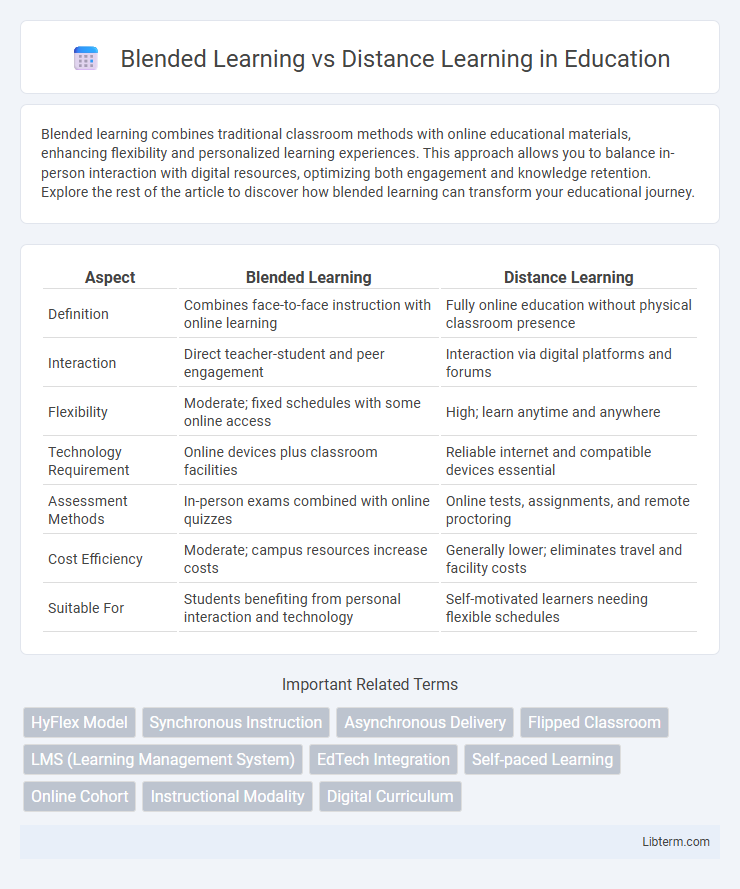Blended learning combines traditional classroom methods with online educational materials, enhancing flexibility and personalized learning experiences. This approach allows you to balance in-person interaction with digital resources, optimizing both engagement and knowledge retention. Explore the rest of the article to discover how blended learning can transform your educational journey.
Table of Comparison
| Aspect | Blended Learning | Distance Learning |
|---|---|---|
| Definition | Combines face-to-face instruction with online learning | Fully online education without physical classroom presence |
| Interaction | Direct teacher-student and peer engagement | Interaction via digital platforms and forums |
| Flexibility | Moderate; fixed schedules with some online access | High; learn anytime and anywhere |
| Technology Requirement | Online devices plus classroom facilities | Reliable internet and compatible devices essential |
| Assessment Methods | In-person exams combined with online quizzes | Online tests, assignments, and remote proctoring |
| Cost Efficiency | Moderate; campus resources increase costs | Generally lower; eliminates travel and facility costs |
| Suitable For | Students benefiting from personal interaction and technology | Self-motivated learners needing flexible schedules |
Introduction to Blended and Distance Learning
Blended learning combines traditional face-to-face classroom methods with online educational materials and interactive activities, creating a hybrid model that enhances student engagement and flexibility. Distance learning, also known as online learning, delivers education entirely through digital platforms, allowing students to access course content remotely without physical presence in a classroom. Both modalities leverage technology to expand access to education, but blended learning integrates in-person interaction, while distance learning relies solely on virtual communication.
Defining Blended Learning
Blended learning combines traditional face-to-face classroom instruction with online educational resources, creating an integrated approach that enhances student engagement and flexibility. It leverages digital tools while maintaining direct teacher-student interaction to support personalized learning experiences. This hybrid model contrasts with distance learning, which is conducted entirely online without regular physical classroom sessions.
Understanding Distance Learning
Distance learning utilizes online platforms and digital communication tools to deliver education remotely, allowing students to access course materials, participate in discussions, and submit assignments from any location. It emphasizes self-paced study, flexibility in scheduling, and often incorporates multimedia content and virtual classrooms to enhance engagement. Key challenges include maintaining student motivation, ensuring reliable internet access, and providing adequate technical support to facilitate effective learning outcomes.
Key Differences Between Blended and Distance Learning
Blended learning combines face-to-face classroom instruction with online educational activities, offering a balanced approach that leverages both in-person interaction and digital resources. Distance learning relies entirely on virtual platforms, enabling learners to access course materials and complete assignments remotely without physical presence. Key differences include the level of student-teacher interaction, with blended learning providing direct engagement, while distance learning emphasizes independent study facilitated by technology.
Benefits of Blended Learning
Blended learning combines face-to-face instruction with online education, offering flexibility that enhances student engagement and retention. This approach supports personalized learning paths, allowing students to learn at their own pace while benefiting from direct teacher interaction. Research shows blended learning improves academic performance by integrating diverse teaching methods and fostering collaboration.
Advantages of Distance Learning
Distance learning offers unparalleled flexibility, allowing students to access coursework anytime and anywhere, which suits diverse schedules and learning paces. It significantly reduces costs related to commuting, accommodation, and physical resources, making education more affordable and accessible globally. Online platforms enhance accessibility to a wide range of programs and expert instructors, supporting personalized learning experiences and fostering digital literacy skills.
Challenges in Blended Learning Environments
Blended learning environments often face challenges such as technological disparities, where unequal access to reliable internet and devices hinders student participation. Instructors must also balance in-person and online instructional methods, which can complicate lesson planning and require advanced digital literacy skills. Student engagement can suffer due to the fragmented nature of learning spaces, making continuous motivation and communication critical for academic success.
Obstacles in Distance Learning Programs
Distance learning programs often face obstacles such as limited student engagement, technological barriers, and lack of direct interaction with instructors, which can hinder personalized feedback and motivation. Students may experience feelings of isolation and struggle with time management without the structured environment present in blended learning models. Furthermore, inconsistent internet access and varying digital literacy levels create challenges in ensuring equitable participation across diverse student populations.
Choosing the Right Approach: Blended vs Distance Learning
Choosing the right approach between blended learning and distance learning depends on the learners' need for flexibility, interaction, and access to resources. Blended learning combines face-to-face instruction with online components, enhancing engagement and practical application, while distance learning offers fully remote education suited for independent study and flexible schedules. Assessing factors such as learning style, technological availability, and course objectives ensures an optimal educational experience.
Future Trends in Education: Blended and Distance Learning
Blended learning integrates traditional face-to-face instruction with online digital media, creating a flexible and personalized educational experience that is projected to grow significantly by 2030 due to advancements in AI-driven adaptive learning technologies. Distance learning, characterized by fully remote education accessed via the internet, is evolving with immersive tools like virtual reality (VR) and augmented reality (AR), enhancing student engagement and overcoming geographical barriers. Future trends indicate a convergence of these models leveraging AI analytics and immersive technologies to deliver scalable, interactive, and competency-based education tailored to diverse learner needs worldwide.
Blended Learning Infographic

 libterm.com
libterm.com